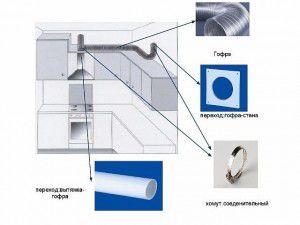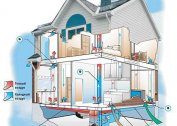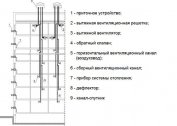The kitchen is one of the rooms in the house that needs intensive ventilation. The cooking process is accompanied by the release of an abundance of moisture and odors. Their distribution throughout the apartment is undesirable and ventilation of the kitchen can prevent it.
Natural ventilation of the kitchen
The design of any private home includes ventilation. However, the natural ventilation of the kitchen does not always satisfy the needs of the owners. Often, most kitchen odors and fumes are not vented through exhaust pipes. Therefore, owners install kitchen hoods, sometimes equipped with filters, sometimes just drawing air into the ventilation duct.
Natural ventilation of the kitchen in a private house is very beneficial, because it does not require additional investment. But good traction is provided with a certain ratio of air temperatures in the house and on the street. Changing the direction or speed of the wind, temperature leads to a violation of traction. In summer, natural ventilation does not work very efficiently, because there is practically no temperature difference inside and outside. Therefore, in the summer, open windows often act as ventilation of the kitchen in a private house.
Forced kitchen ventilation
The easiest option for forced ventilation of the kitchen in the house is a cooker hood, directing air from the kitchen directly to the street. This option is not bad, because the hood is installed directly above the hob. When hanging it, it is important to follow the manufacturer's recommendations. Too high a fume hood will not do the job. The optimum distance to the gas stove is 60 - 80 cm, to the electric 50 - 70 cm.
Hoods produce a filter and exhaust type. The first only passes air through the filter system and issues it back. At least every 6 months, it is necessary to change or clean the filter (depending on its type).
An exhaust system is actually an exhaust fan with a duct. When installing the exhaust pipe, the following features must be considered:
- The number of pipe bends should be minimal;
- The shorter the pipe, the better;
- The angle should not be sharper than 90 degrees;
- Corrugated pipes are the worst option, since the inner ribs impair the movement of air flow.
Supply and exhaust ventilation systems for the kitchen
This type of ventilation of the kitchen in the house not only draws air, but also replaces it with filtered air from the street. Cons of the system: cumbersome installation of two ducts and a fan, high cost.



